Uxmal: A Stone Legend
Words: Indi Blake
Words and Photos: Indi Blake
Imagine you were born into the Mayan classical period around the year 900 in Mexico’s Yucatán Peninsula. If you were fortunate, you may have had the opportunity to journey into Uxmal, a legendary city you would have likely heard about as a child, and one of the most important Mayan sites of all time. As you entered the city, you would be met with a vibrant, bustling town of around twenty-five thousand inhabitants with many more thousands in the surrounding areas. Nearing the city center, hulking stone structures would have blocked out the sun as you approached. Their mass, towering above even the highest trees, would have shattered the limits of what you had thought was possible. Intricately adorned buildings, representing thousands of hours of work would have reassured you that the lords and religious elders who commissioned these buildings were indeed anointed by the gods.
At the time, this era would have been seen as the golden age for your people, and Uxmal would have been the peak of this splendor. It was a time when Mayan elders in the local kingdoms were busy learning about astronomy and undertaking groundbreaking civic projects. By this time, Mayan life was interwoven with rich cultural traditions, colorful religious rituals, and a complex history already going back hundreds of years. Expansive trade networks would have spanned thousands of miles in every direction with rare commodities like obsidian and gold trading hands along the way. Mayans in 900 used a sophisticated system of writing and had even puzzled over mathematics. They were also among a surprisingly rare subset of civilizations that had conceptualized the number zero and included it in their mathematical toolbox. Some pre-Hispanic Mayan inventions have persisted to this day, including a cyclical calendar that, more than a millennium after its creation, inspired worldwide fear about the end of the world back in 2012. Mysteriously, the Mayan civilization would face a dramatic collapse only a few hundred years later, and even though their descendants live on to this day, the ancient Mayan society would never regain the same preeminence.
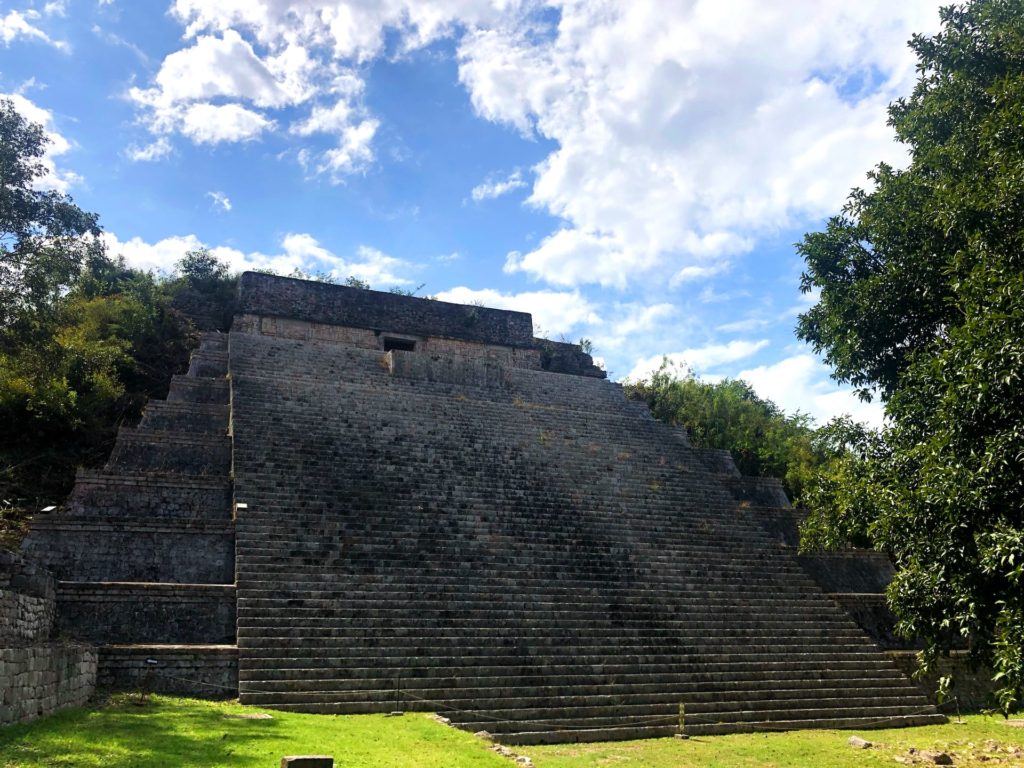 One of the lesser-known pyramids at the site.
One of the lesser-known pyramids at the site.
In the southwest of the Yucatán Peninsula lies a series of low hills known as the Puuc region. The jungles of this region hide an astounding density of ancient stone cities, each one boasting numerous structures and marvels of stonework. Uxmal was the most prominent and powerful Mayan city in this area and acted as the religious and cultural capital of Puuc. Featuring awe-inspiring stone structures, it is a prime example of the architectural might of the Mayan people. Alongside other sites like Chichén Itzá, Tikal, and Palenque, Uxmal represents masonry wonders on par with other historic marvels like the Pyramids of Giza or the Great Wall of China. The site, which is designated as a UNESCO World Heritage Site, now holds some of the best preserved evidence of Mayan history and is considered a treasure trove of material for scientists hoping to reveal lost secrets about the Mayan world.
Mayan history is a fascinating tale of expansion, innovation, and power. Lineage can be traced back to nomadic Indigenous groups living around Central America and southern Mexico, who around 6000 BCE began to harness agriculture and develop a more sedentary lifestyle. These small village groups were some of the original cultivators of many of the vegetables we still enjoy today, such as corn, beans, and squash. In fact, it’s thanks in part to these farmers’ knack for selective breeding that these foods are so delicious and widely available today. As these small villages became more efficient in producing surplus food, they began to grow.
Evidence suggests that by around 2000 BCE, early settlers had become a distinct group, complete with their own unique customs and political order, thus beginning the preclassic age of the Maya. Growing villages eventually gave rise to more disparate power structures with a ruling class of chiefs and religious figures that governed over workers. This power dynamic meant that rulers could organize large-scale communal civic projects like water collection and road building. By 200 CE, villages in the area had grown into regional city-states, each with its own traditions and leaders.
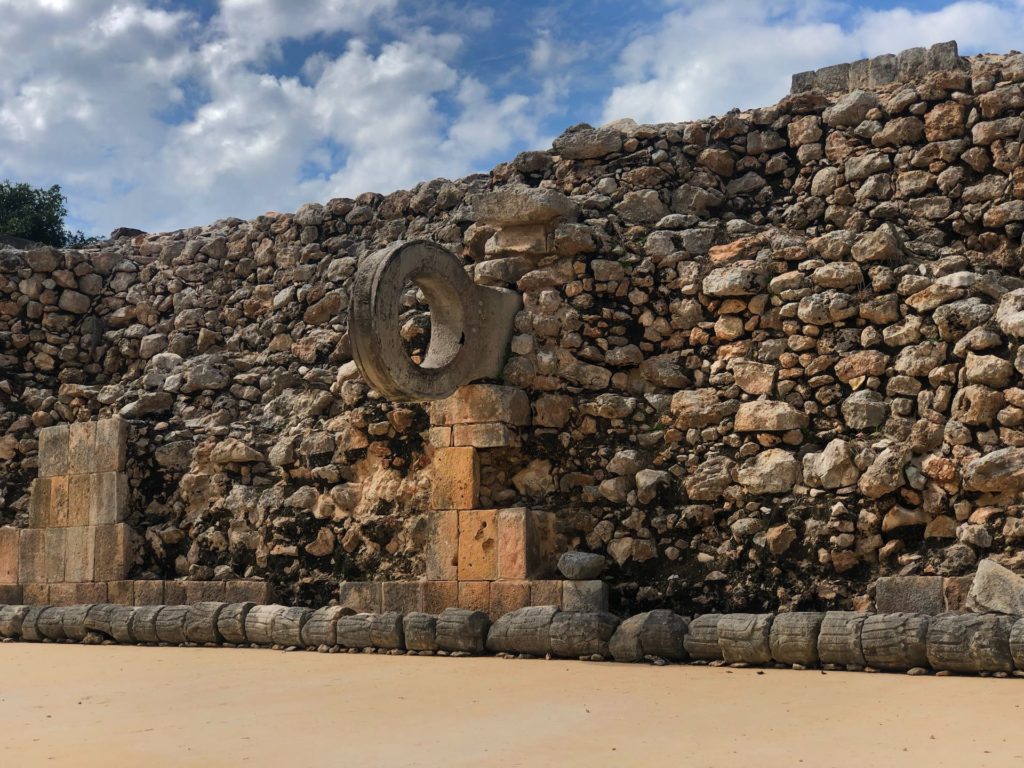 A stone hoop in Uxmal's ball court.
A stone hoop in Uxmal's ball court.
From 200 to 900 CE, the Mayan world exploded with productivity. This era, known as the classic period, is defined by the ascent of well-known localities, such as Tikal in Guatemala, which were in their prime. It was during this time that Mayan civilization developed into something unique, becoming the largest society in the Americas. It would be another few hundreds of years before Aztec and Incan civilizations would ascend to similar heights of societal achievement. Uxmal had its humble beginnings, starting out as one of many small cities in the area.
Regional disputes and warfare between southern Maya city-states combined with sustained drought likely contributed to the collapse of southern cities and persuaded Mayan migration north that revitalized the cities there, including Uxmal. Near the end of this classic era, around 850, Uxmal underwent a flurry of construction that produced some of the most recognizable structures of the site. This dawned in what is known as the postclassic period when Mayan power was still at an all-time high, but various pressures began to bear down on the civilization. Uxmal was the largest and most powerful kingdom at the beginning of this era, with allies further north in the kingdom of Chichén Itzá, further cementing their position on top. Interestingly, evidence suggests that around 1000 CE, Toltec cultures from the heart of Mexico, the same that would later give rise to the Aztec empire, began to influence Mayan culture. Some of the most compelling evidence of this is in the sudden inclusion of statues and effigies into the Uxmal architecture of Quetzalcoatl: the winged serpent that had become a primary figure in central Mexican religion.
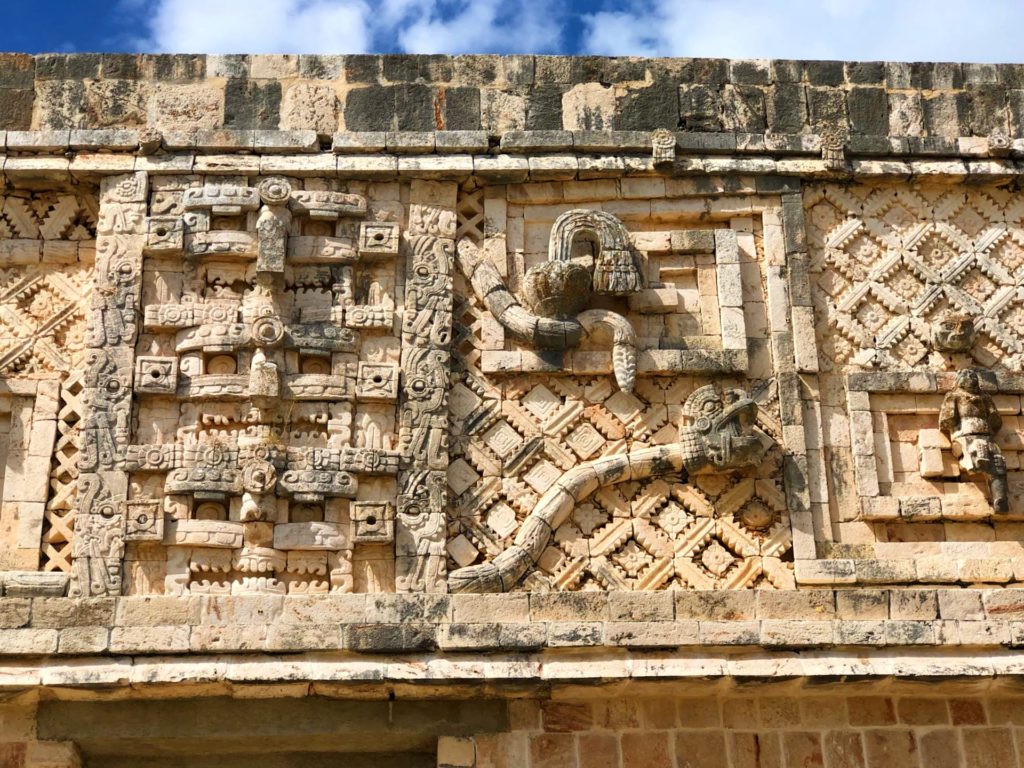 An intricate carving showing impressions of Chaac masks and a draped snake.
An intricate carving showing impressions of Chaac masks and a draped snake.
At the beginning of the site’s creation, large stone and earth platforms were formed into sturdy foundations. The stones used in the structures sitting atop these platforms were quarried out of local limestone commonly found throughout the area and were stacked and fitted together with amazing accuracy. Unless intentionally decorated, stones facing outward were often cut so precisely that the surfaces of walls were completely flush and gaps between stacked stones have been fitted so tightly that no light shines through. Arches were a central theme in Mayan architecture and the most simplistic corbeled arch was ubiquitous in nearly all sites. Many of the internal rooms and chambers within the structures utilized some form of this arch, with the chambers’ tapering walls joined together at the peak and topped off with large capstones.
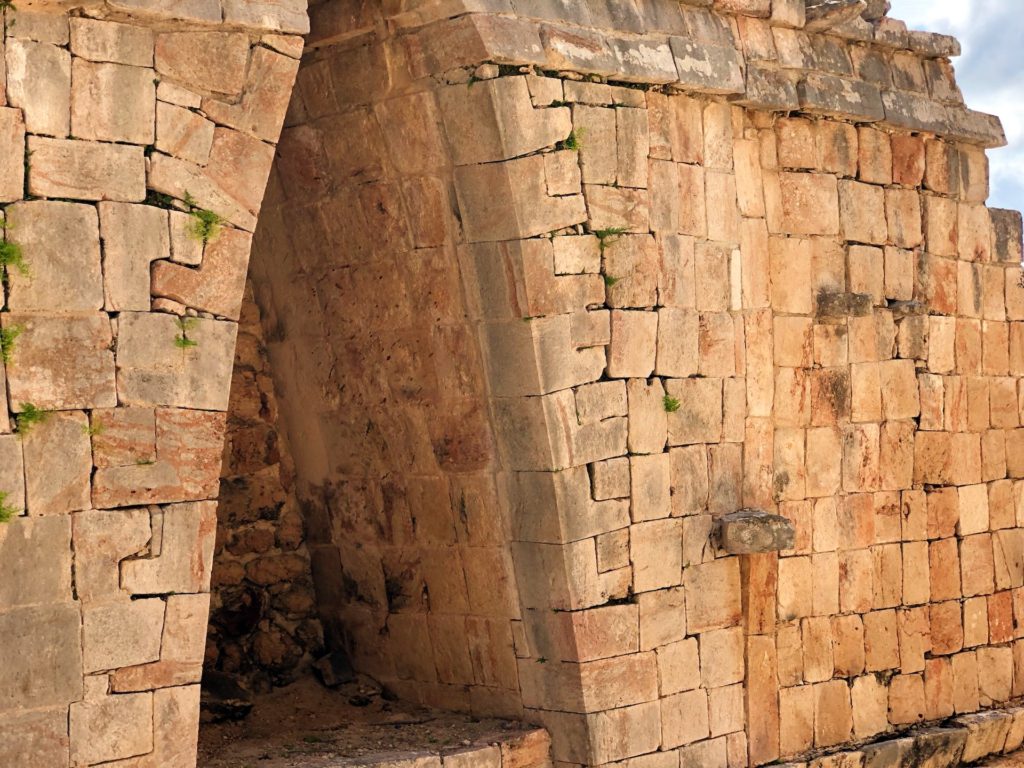 An arch with exposed stone that reveals how it was built.
An arch with exposed stone that reveals how it was built.
During Uxmal's height of power, the city center had expanded to include many dozens of massive stone structures. The scale of the site is quite jarring, as many of the buildings are huge even by today's standards and the sheer number of them boggles the mind. Because of the rapid degradation of wood based architecture, historians have little idea about the true extent of the surrounding city as only those buildings made out of stone remain. What is clear is that Uxmal had enough laborers and political cohesion to painstakingly cut and stack thousands of tons of stone by hand and the expertise to engineer this ambitious metropolis. Through the careful study of structures at Uxmal, it is also clear that its creators had vast knowledge of astronomy. Mayan architects built their city aligned with the cardinal directions: north, south, east, and west. The one building that does not conform to this pattern, known as the Grand Palace, is oriented toward Venus and thought to have astronomical significance. Attention to the sun's position during equinoxes and solstices was carefully taken into account for each building in order to cast unique shadows on dates relevant to farming and ritual.
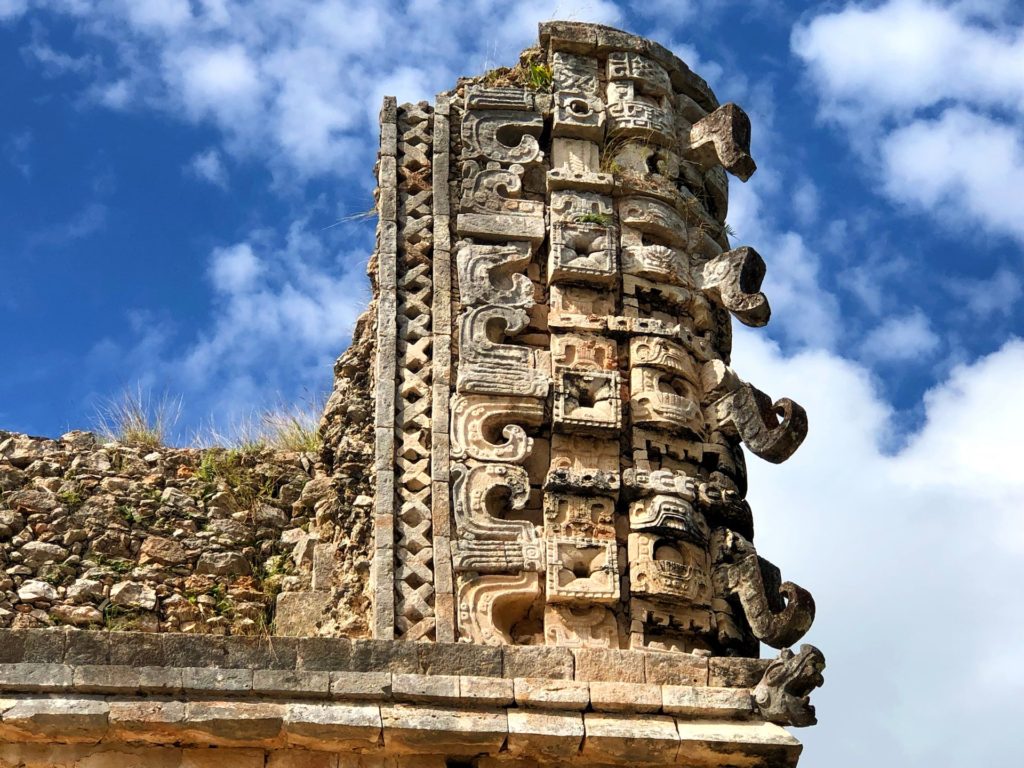 A stack of Chaac masks above a small pyramid.
A stack of Chaac masks above a small pyramid.
The masonry on display at Uxmal is some of the most impressive of all Mayan sites. Unlike many of the cities built before it, the structures in Uxmal utilized cementos lime compounds made by superheating crushed limestone to create mortar used to bind stones together. This may contribute to the exceptional condition of the structures in the city when compared with others of the same age. Amazingly, much of the quality of the artwork and craftsmanship of the delicate stone decorations has been preserved, giving archaeologists crucial insight into Mayan life.
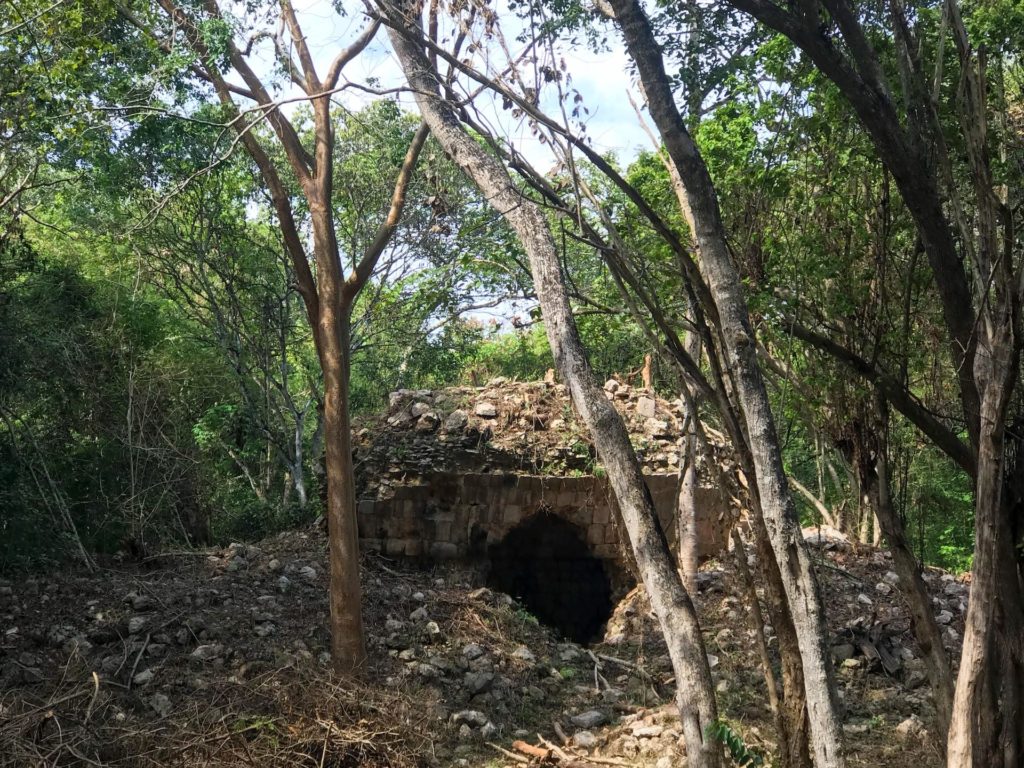 The crumbled remains of a building yet to be restored. Many structures looked like this prior to restoration.
The crumbled remains of a building yet to be restored. Many structures looked like this prior to restoration.
Much about Uxmal as a functioning city remains mysterious. The exact purposes of some of even the most notable structures at the site are still relatively unknown. The full extent of the society's scientific knowledge and the true nature of their religious traditions have been lost to time. It is clear that religion played a major role in the society and many of the buildings reflect that, being used for ceremonies and rituals. Carved facades throughout the city depict the Mayan rain god, Chac, and Itzamná, who sometimes appeared as an underwater two-headed serpent and was thought of as the ruler of heaven, day, and night, among others who were so revered. This imagery reinforces the importance of religion and the impact it had on Mayan life. Trade also constituted a large part of daily life for the Maya, and as such, some buildings are thought to have been gathering places for townspeople or visitors to barter, much like a modern-day market. The Grand Palace was almost certainly used by the elites as living quarters and outposts from which to govern. In the heart of Uxmal is a grand ball court that was used for ancient sports. Giant stone rings jutting out from opposing walls acted as goals through which balls would be launched by athletes for the entertainment of the lord kings. The modern post-Hispanic Maya continue to play a version of this sport to this day called Pok-a-Tok.
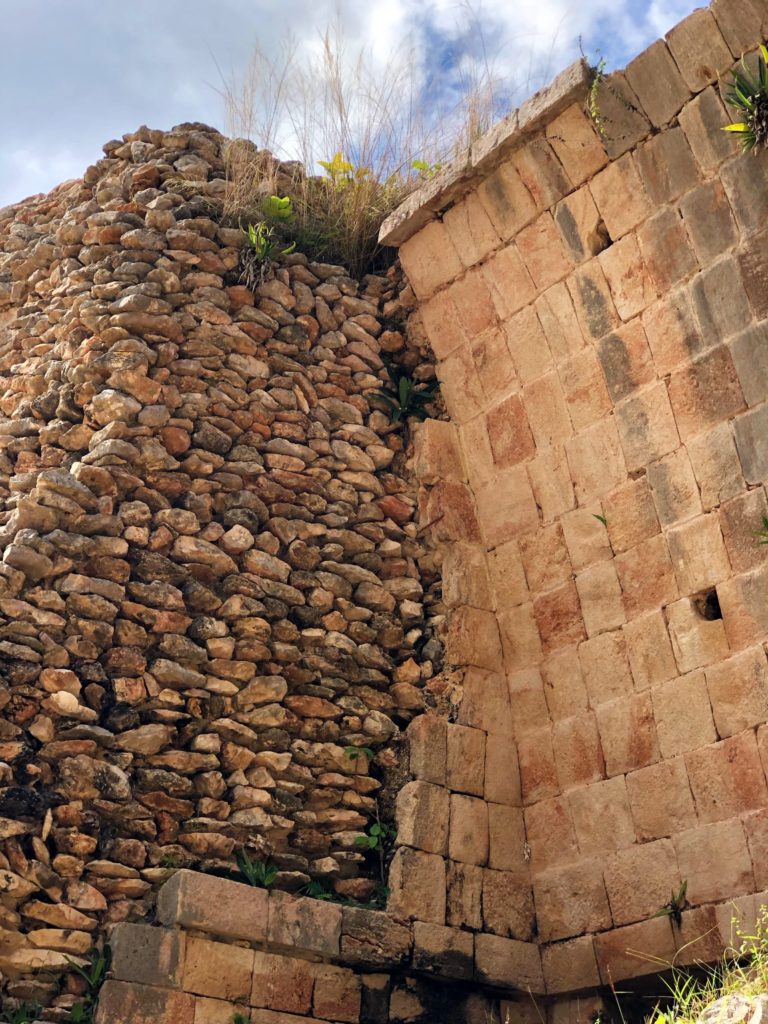 A fallen wall exposing stone that shows the difference in stone shapes used in the exterior vs. interior of the wall.
A fallen wall exposing stone that shows the difference in stone shapes used in the exterior vs. interior of the wall.
The most impressive buildings in Uxmal, and undoubtedly the most famous, are the pyramids whose purpose was ritualistic and used for sacrifice. The tallest pyramids, penetrating through the jungle canopy, also acted as important landmarks used to navigate through the otherwise uniform expanse of vegetation. Uxmal’s tallest pyramid, Adivino or Pyramid of the Magician, is the basis for a famous legend in Mayan culture that still persists as a popular Yucatecan fable to this day. The legend tells of a magic dwarf, who, through a series of tasks and challenges, and with the help of his grandmother, outwits and overthrows the ruler of Uxmal. To celebrate, the dwarf uses his magic to build the massive pyramid as his palace overnight, from which he governed wisely for many years. The true nature of the structure is not quite as riveting but is still quite mysterious. Seismic data and recent excavations have revealed that the massive structure likely started out as three to five smaller structures that were built on top of each other, creating one megastructure that stands a whopping 115 feet tall and 280 feet wide—a full 17 feet taller than the famous “Castillo pyramid” at Chichén Itzá. While its style is similar to other Mayan pyramids in the area, the Pyramid of the Magician is unique in that it does not conform to the square style seen in the vast majority of other Mayan structures, instead having rounded corners giving it an almost elliptical base. On each side of the pyramid run steps leading up to the peak where a doorway carved into an ominous snake's mouth leads to two stories of temples, each complete with carved facades and numerous rooms. The effect is exceptionally impressive and must have struck fear into Uxmal’s’ enemies’ hearts, as they were led up the stairs to be sacrificed.
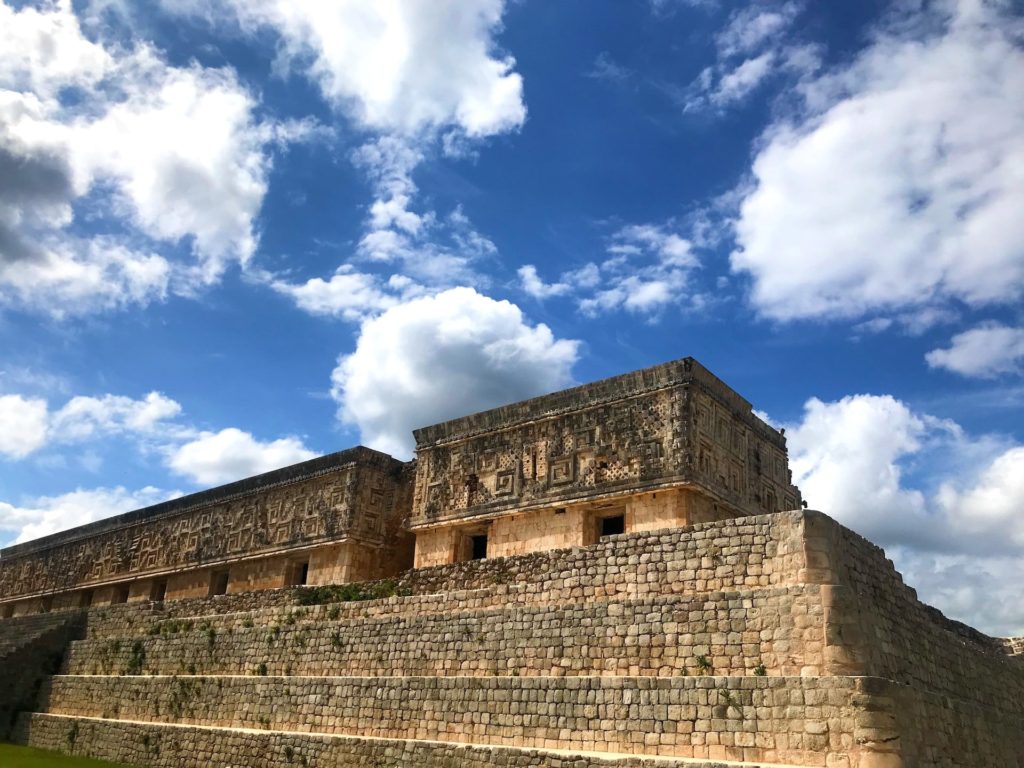 The Governor's Palace is one of the single biggest buildings on the site.
The Governor's Palace is one of the single biggest buildings on the site.
Though the exact dates and circumstances surrounding its fall are somewhat controversial among archaeologists, most agree that Uxmal had lost its grip on regional power by 1100. Some archaeologists claim that a conflict with old allies from the kingdom of Chichén Itzá broke out and contributed to the city's fall. Perhaps the Toltec influence destabilized the culture. Whatever the reason, by the time the Spaniards arrived 400 years later, Uxmal was merely a shadow of what it once was. Descriptions of the site by European explorers paint a picture of an overgrown, crumbling city. Its once mighty population had reduced to a tiny fraction of what it once was. People had continued to live in the area and some continued to use Uxmal for traditional or religious purposes, but the days of spectacular growth and prosperity were long gone.
The ancient masonry at Uxmal deep in Mexico's Yucatán jungle is a testament to the duration of the craft. Almost all of what we know about this culture stems from their use of stone. While nearly all other relics of Mayan culture have long since decayed, the stone still sits in much the same way as it has since it was first placed, now ruled by iguanas and vines rather than lord kings. The awe and wonder that onlookers would have felt a thousand years ago as they witnessed Uxmal is still felt today by the hundreds of visitors the site draws from all over the world annually. Many lifetimes’ worth of time and effort spent cutting and stacking stones has paid off in a thousand years of admiration from lucky visitors, and even though the golden age is over, Mayan civilization stands proudly as one of the ancient world’s biggest and most interesting examples of human achievement.